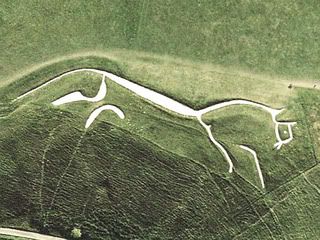The White Horse of Uffington
 The cutting of huge figures or geoglyphs into the turf of English hillsides has been going on for more than 3000 years. There are 56 hill figures scattered around England, with the vast majority on the chalk downlands of the southern part of the country. The figures include giants, horses, crosses and regimental badges. Though the majority of these glyphs date within the last three hundred years or so there are one or two that are much older.
The cutting of huge figures or geoglyphs into the turf of English hillsides has been going on for more than 3000 years. There are 56 hill figures scattered around England, with the vast majority on the chalk downlands of the southern part of the country. The figures include giants, horses, crosses and regimental badges. Though the majority of these glyphs date within the last three hundred years or so there are one or two that are much older.
The most famous of these figures is perhaps also the most mysterious, the Uffington White Horse in Oxfordshire. The White Horse has recently been redated and shown to be even older than its previously assigned ancient pre-Roman Iron Age date. More controversial are the Cerne Abbot Giant in Dorset and the enigmatic Long Man of Wilmington in Sussex. What was the purpose of these giant figures, who carved them, and how have the oldest examples survived for perhaps thousands of years?
The method of cutting these huge figures was simply to remove the overlying turf to reveal the gleaming white chalk below. However, the grass would soon grow over the glyph again unless it was regularly cleaned or scoured by a fairly large team of men and women. One reason that the vast majority of hill figures have disappeared is that when the traditions associated with the figures faded, people no longer bothered or remembered to clear away the grass to expose the chalk outline. Furthermore, over hundreds of years the outlines would sometimes change due to the scourers not always cutting in exactly the same place, thus changing the shape of the original glyph.
The fact that any ancient hill figures survive at all in England today is testament to the strength and continuity of local customs and beliefs which, in one case at least, must stretch back over millennia.
The White Horse of Uffington
The oldest and most famous hill figure in England is the 110m long and 40m high Uffington White Horse, located 2.5km south of the village of Uffington on the Berkshire Downs, Oxfordshire. This unique stylized representation of a horse consists of a long sleek back, thin disjointed legs, a streaming tail, and bird-like beaked head. The elegant creature almost melts into a landscape rich in prehistoric sites. The Horse is situated on a steep escarpment, close to the Late Bronze Age (c7th century BC) hillfort of Uffington Castle and below a long distance Neolithic Track called the Ridgeway.
The Uffington Horse is also surrounded by Neolithic and Bronze Age burial mounds. It is only 1.6km from the Neolithic Chambered long barrow of Wayland’s Smithy and not far from the Bronze Age cemetery of Lambourn Seven Barrows. The carving has been placed in such a way as to make it extremely difficult to see from close quarters, and like many geoglyphs it is best appreciated from the air. Nevertheless, there are certain areas of the Vale of the White Horse, the valley containing and named after the enigmatic creature, from which an adequate impression may be gained. Indeed on a clear day the carving can be seen from up to 30km away.
The earliest documentary reference to a Horse at Uffington is from the 1070’s when ‘White Horse Hill’ is mentioned in Charters from the nearby Abbey of Abingdon, and the first reference to the Horse itself is soon after, in 1190. However, the carving is believed to date back much further than that. Due to the similarity of the Uffington White Horse to the stylized depictions of horses on 1st century BC Celtic coins, it had been thought that the creature must also date to that period.
Scientific Dating of the Horse
However, in 1995 Optically Stimulated Luminescence (OSL) testing was carried out by the Oxford Archaeological Unit on soil sediments from two of the lower layers of the Horses body, and from another cut near the base. The result was a date for the Horse’s construction somewhere between 1400 and 600BC, in other words it had a Late Bronze Age or Early Iron Age origin. The latter end of this date range would tie the carving of the Horse in with occupation of the adjacent Uffington hillfort, and may perhaps represent a tribal emblem or symbol marking the land of the inhabitants of the hillfort. Alternatively the carving may have been created for ritual / religious purposes.
Pages: 1 2